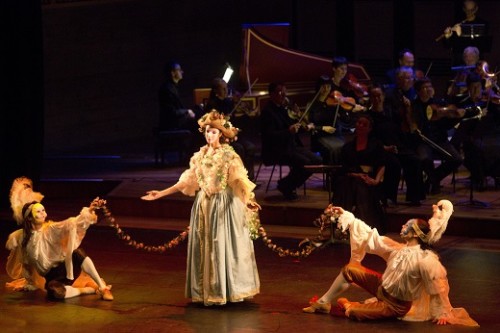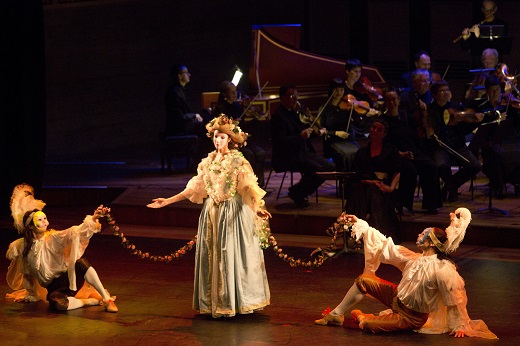 United Kingdom André Campra, Marc-Antoine Charpentier, Jean-Baptiste Lully, Jean-Philippe Rameau and others: Anna Dennis (soprano), Nick Pritchard (tenor), Les Corps Éloquents (Hubert Hazebroucq [dancer/choreographer] and dancers: Irène Feste and Romain Arreghini), Orchestra of the Age of Enlightenment / John Butt (harpsichord/conductor), Queen Elizabeth Hall, London, 26.6.2018. (JPr)
United Kingdom André Campra, Marc-Antoine Charpentier, Jean-Baptiste Lully, Jean-Philippe Rameau and others: Anna Dennis (soprano), Nick Pritchard (tenor), Les Corps Éloquents (Hubert Hazebroucq [dancer/choreographer] and dancers: Irène Feste and Romain Arreghini), Orchestra of the Age of Enlightenment / John Butt (harpsichord/conductor), Queen Elizabeth Hall, London, 26.6.2018. (JPr)

This was an education for me in the origins of what we consider today to be opera and ballet. In the very informative printed programme we learn from Tom Short about the part played in this by Louis XIV and the court rituals at the Palace of Versailles late in the second-half of the seventeenth century. Apparently, the palace remains ‘a byword for intrigue, hedonism and spectacle’. Louis danced himself and his ‘most famous role came in the Ballet de la Nuit, a thirteen-hour long production in which the king appeared with the coming of the day as the God Apollo’. This apparently inspired Louis to declare himself Roi Soleil (Sun King). (As an aside – as interesting as this presentation was for the most part – by the time an advertised finishing time had been exceeded by nearly thirty minutes it also seemed as long as that ballet Louis was in!)
Apparently, Louis’ genuine interest in dance also helped him shore up his reign since the thoughts of the nobility ‘could hardly turn to rebellion if they were preoccupied with learning fancy footwork.’ Jean-Baptiste Lully – who came originally from Florence – had begun by giving Louis dance lessons and eventually became the royal composer. He collaborated with the dramatist Phillipe Quinault and choreographer Pierre Beauchamp on the forerunner of what we think of today as opera. Tragédie en musique was therefore multidisciplinary and ‘contained allegorical prologues which sang Louis’ praises, and plots which often featured thinly-disguised representations of the King.’
Hubert Hazebroucq is artistic director of Les Corps Éloquents whose aim is to promote and perform this early repertoire with live music – as here with the Orchestra of the Age of Enlightenment at the Queen Elizabeth Hall. He explained in the programme how most of the dances we saw are ‘original choreographies, on original music, […] We can reconstruct them thanks to a specific system of dance notation, named from its inventors, the “Beauchamp-Feuillet” notation.’ The evening was called ‘Dangerous Liaisons’ and there were seven scenes across two acts with the titles: ‘Idyllic Delight’, ‘Seduction’, ‘Interlude: Ballet des Fleurs’, ‘Vexation’, ‘Loss and Despair’, ‘Frolics and Mischief’ and ‘Reconciliation’.
What we saw from Les Corps Éloquents’ three hard-working dancers had its roots mostly in mythology: a shepherdess could be being pursued by a shepherd at one time or later by Mercury; they might represent lovers in Spain; tell the tale of Orpheus seeking Eurydice; or take part in the parodied antics of Apollo, Daphne and Harlequin. The highlight for me was the scene when the two male dancers swirled around the stage with gauzy capes and masks with puffed-out cheeks as the wind-gods Boreus and Zephirus pursuing Flora, another shepherdess I suspect. This Ballet des Fleurs was a ‘floral divertissement’ and featured the impeccably committed OAE – under the accomplished direction of John Butt at the harpsichord – giving it a suitable airy accompaniment with Lisa Beznosiuk’s eloquent flute much to the fore here and throughout many of the pieces we heard. Together with two singers and some colourful lighting for the otherwise bare stage the idea was to create a small drama – as was common practice in Louis’ time – from ‘bleeding chunks’ of period operatic works and dances.
However elegantly Hazebroucq, Irène Feste and Romain Arreghini danced, the repetitive nature of the steps and hand gestures cannot be ignored. Also, only occasionally did the OAE get out of first gear to whip up a storm such as with some Marais music before the interval. Nick Pritchard (no relation!) displayed refined musicianship and a light, almost ethereal, tenor voice and never more so than as Charpentier’s Orphée. Anna Dennis got the showiest aria, Rameau’s ‘Air de la Folie’, with its opening line (in translation) ‘Let’s make some noise, let’s make merry’. That she did indeed with a scintillating display of her considerable vocal technique! What we saw danced and heard played and sung epitomised the ‘galant’ style which superseded the Baroque. If this was your sort of thing then you will have enjoyed it a little more than I did. I cannot criticise the performances at all, but I would have liked less of all three and perhaps a narrator to explain what we were seeing and hearing.
Jim Pritchard
For more about the OAE click here.
